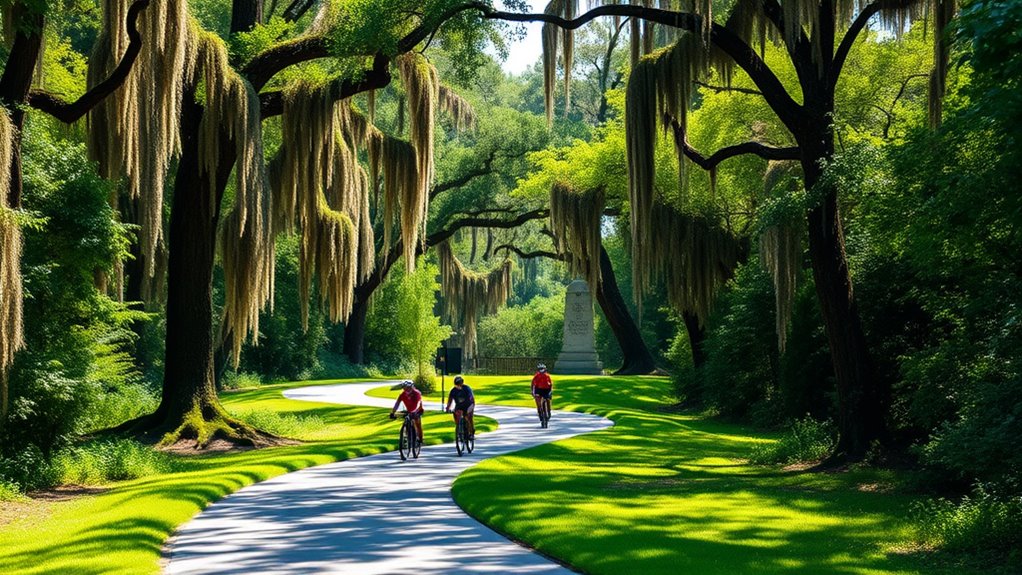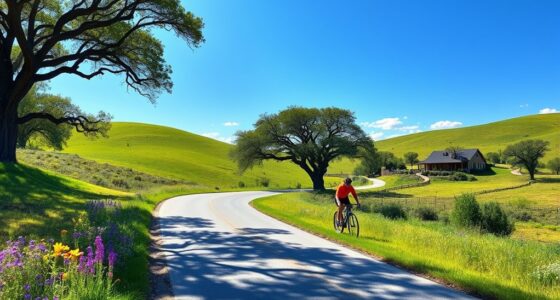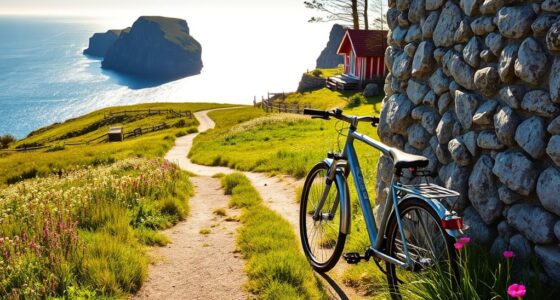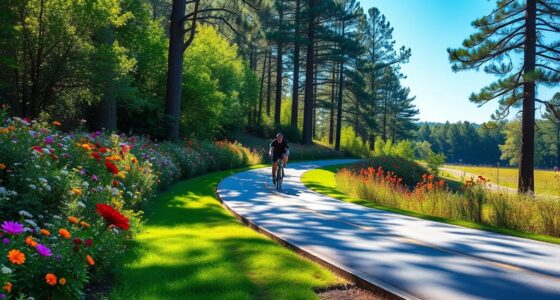Pedaling along Mississippi’s Natchez Trace lets you experience a unique mix of rich history and breathtaking landscapes. This historic route, once a Native American trail, connects diverse cultures and showcases significant landmarks like Emerald Mound and Mount Locust Inn. With its scenic parkway offering bike-friendly paths and low traffic, you can safely explore varied ecosystems and wildlife. For a deeper insight into the Trace’s fascinating past and best spots to visit, keep going!
Key Takeaways
- The Natchez Trace Parkway spans 444 miles, providing a scenic and historical route ideal for cycling enthusiasts.
- Biking the Trace allows cyclists to explore diverse landscapes, including forests, wetlands, and prairies.
- Historical landmarks like Emerald Mound and Mount Locust Inn enrich the cycling experience with cultural significance.
- The parkway is free from commercial traffic, ensuring a safer and more enjoyable ride for cyclists.
- Five designated bicycle-only campgrounds offer convenient accommodations for overnight adventures along the route.
Discovering the Natchez Trace: A Historical Overview
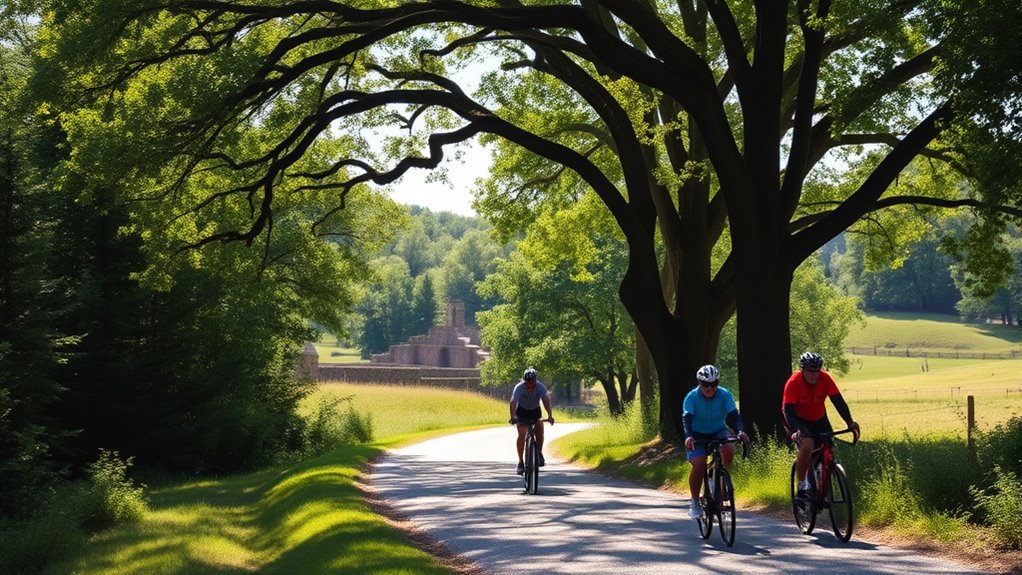
The Natchez Trace, a winding pathway steeped in history, has long served as a vital route for trade and communication.
Originally a game trail for Native American tribes like the Choctaw, Natchez, and Chickasaw, it evolved from prehistoric footpaths made by bison and deer. These Native Americans enhanced the trail, using it to connect settlements such as the Pharr Mounds near Tupelo, Mississippi.
The first European to traverse the entire Trace was an unnamed Frenchman in 1742. By the late 18th and early 19th centuries, explorers and traders relied on it heavily. Inns and trading posts, known as “stands,” sprang up along the route, making it essential for travel, commerce, and military movements during key conflicts like the War of 1812.
The Diverse Landscapes of the Trace

Exploring the Natchez Trace reveals a stunning array of landscapes that showcase the region’s rich ecological diversity.
As you pedal along, you’ll encounter diverse forest types, like oak-beech and oak-hickory, that create a vibrant canopy overhead. Wetlands and swamps offer unique ecosystems, while open prairies present a stark contrast with their diverse plant life. Agricultural lands highlight human interaction with this beautiful terrain.
You’ll also traverse the southern Appalachian foothills, crossing eight major watersheds and twelve physiographic regions, each contributing to the Trace’s varied geological features.
Keep an eye out for wildlife, including white-tailed deer and wild turkeys, in the bottomland hardwood and upland hardwood forests that line your path, enriching your ride with nature’s splendor.
Key Historical Landmarks Along the Route
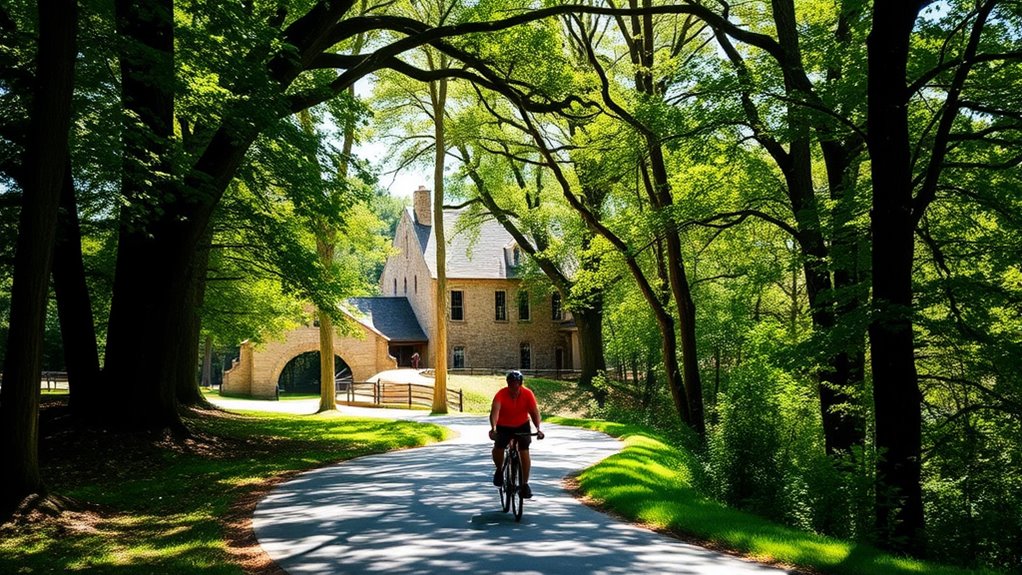
As you journey along the Natchez Trace, you’ll encounter key historical landmarks that tell the story of this iconic route.
Don’t miss Emerald Mound, one of the largest Native American mounds in the U.S., or the ancient Bynum Mounds, showcasing Middle Woodland Period history.
Nearby, explore the Boyd Mounds Site and Janet’s Mound, rich in archaeological significance.
Historic inns like Mount Locust Inn and Grinder’s Stand offer glimpses into the past, providing lodging for travelers.
You’ll also pass sites linked to notable figures like Meriwether Lewis and Andrew Jackson, who shaped the region’s history.
Each landmark enriches your ride, connecting you to the rich tapestry of culture and history along the Trace.
The Role of Early Travelers and Trade
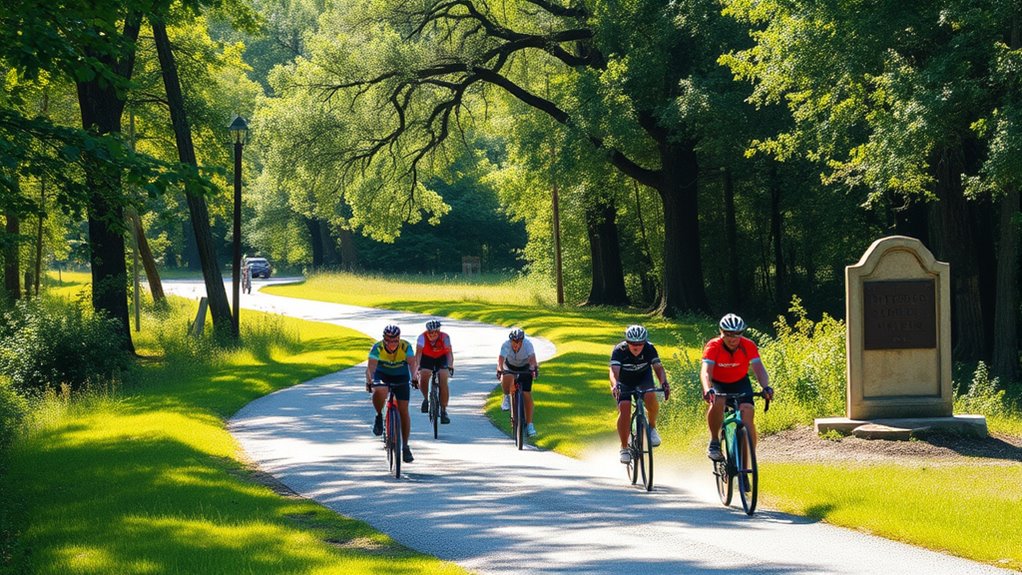
While traversing the Natchez Trace, you’ll discover the vital role early travelers played in shaping its history and trade networks.
Initially used by Native Americans like the Choctaw and Chickasaw for hunting and trade, the trace later welcomed European explorers such as Hernando de Soto. This path, forged by the movement of bison and deer, connected diverse tribes, fostering economic and cultural exchanges.
As you pedal, imagine the Kaintucks returning home from Natchez and New Orleans, transporting goods like livestock and coal. Inns sprang up along the route to provide rest for weary travelers, highlighting the trace’s significance in the early economy.
Each turn of the path tells a story of connection and commerce that shaped the region.
The Rise and Fall of the Natchez Trace as a Trade Route
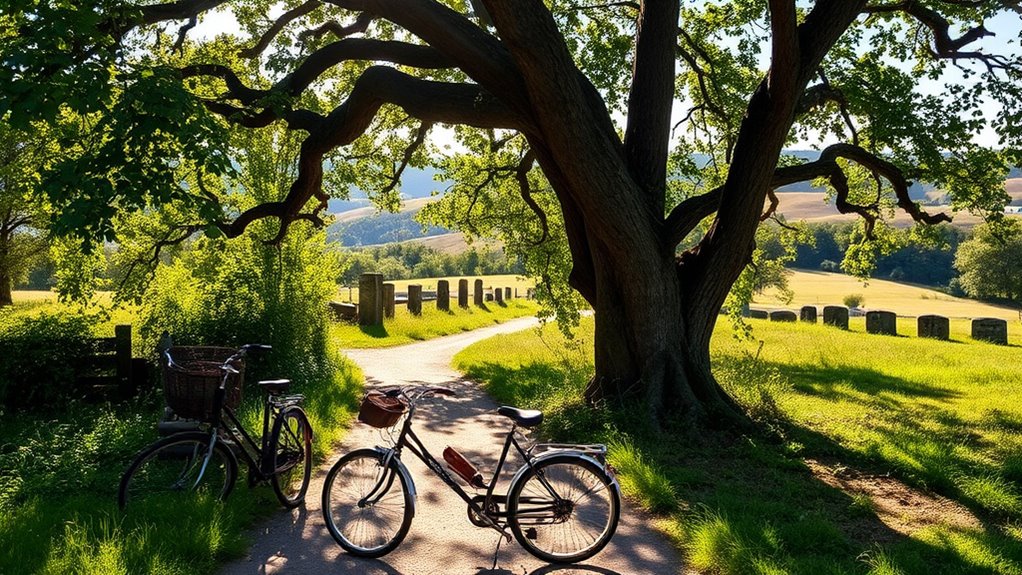
The Natchez Trace emerged as a crucial trade route in the late 18th century, connecting the burgeoning settlements of Nashville and Natchez. Native Americans first used the trail, which European settlers later improved for trade.
This 440-mile path became vital for commerce, linking the Tennessee and Mississippi rivers. Inns and trading posts sprang up to support travelers, while the U.S. Army enhanced it for wagon use in 1801.
However, by the 1830s, the Trace’s significance waned as steamboats and new roads offered faster alternatives. Many inns closed, and sections fell into disrepair.
Ultimately, the Natchez Trace transitioned from a thriving trade route to a forgotten path, reshaping the region’s economic landscape forever.
Cycling the Natchez Trace Parkway: An Ideal Experience

Cycling the Natchez Trace Parkway offers an unforgettable experience for outdoor enthusiasts and history buffs alike. With its 444 miles designated as a bike route, you’ll enjoy a peaceful ride on scenic roads free from commercial traffic.
The maximum speed limit of 50 mph ensures a safer environment for cyclists, while the absence of stop signs or traffic lights reduces accident risks. Numerous access points and clear signage remind drivers to share the road.
Along the way, you’ll find five bicycle-only campgrounds and various cycling-friendly accommodations. Whether you choose a short jaunt or the full route, the parkway invites you to explore its rich history and stunning landscapes at your own pace.
Scenic Highlights for Cyclists

Exploring the Natchez Trace Parkway reveals a feast for the eyes, packed with breathtaking views and historical treasures.
As you ride, enjoy the stunning landscapes of forests and farmland that stretch across Mississippi, Alabama, and Tennessee. You’ll encounter serene creeks and rolling hills, providing a delightful mix of flat and undulating terrain.
Don’t miss the picturesque overlooks of the Barnett Reservoir or the tranquil cypress swamps, which showcase the area’s diverse ecosystems.
Along the route, historical attractions like antebellum homes and Civil War battlefields enrich your experience. Plus, charming Southern towns invite you to savor local cuisine and immerse yourself in the region’s culture.
Each pedal stroke unveils a new scenic highlight waiting to be discovered.
Safety Tips for Exploring the Trace by Bike

When biking the Natchez Trace Parkway, prioritizing safety is essential for an enjoyable experience. Avoid low visibility times like dawn and dusk, and wear high-visibility clothing. Flashing lights on both the front and rear of your bike will help you stand out.
Remember to follow traffic rules, as you’ll share the road with vehicles, particularly in busier areas like Jackson and Nashville. Since there are no bike lanes, be cautious of narrow lanes and curves that can affect visibility.
Practice defensive riding techniques and be aware of the three-foot passing rule for motorists. Lastly, utilize resources from the National Park Service for maps and tips to ensure your ride is both safe and fun.
Embracing Nature and History on Two Wheels

As you pedal along the Natchez Trace Parkway, you’ll find yourself immersed in a stunning blend of nature and history. Spanning 444 miles, this scenic route offers rolling hills, lush forests, and picturesque farmland.
Keep your eyes peeled for wildlife like deer and turkey that may cross your path. You’ll also encounter historical sites such as the Emerald Mound and Mount Locust, rich with stories of Native American heritage and Civil War connections.
With a smooth surface and low traffic, you can ride at a leisurely pace, soaking in the beauty around you. Don’t forget to engage with local communities, who warmly welcome cyclists and celebrate the rich culture and history of this remarkable trail. Additionally, the area promotes cognitive growth through various outdoor activities that inspire families to explore and learn together.
Frequently Asked Questions
What Is the Best Time of Year to Cycle the Natchez Trace?
The best time of year to cycle the Natchez Trace is during spring and fall.
You’ll enjoy mild temperatures, typically between 60-70°F, which makes your ride comfortable.
Spring can be a bit wetter, while fall often offers drier conditions and beautiful foliage.
Avoid the summer heat and humidity, as well as the cold and potential rain in winter.
Plan your trip for these shoulder seasons to maximize your cycling experience!
Are There Guided Tours Available for Biking the Natchez Trace?
Yes, there are guided tours available for biking the Natchez Trace!
Companies like Discovery Bicycle Tours and Wilderness Voyageurs offer multi-day trips that combine cycling with historical sights and cultural experiences.
You’ll enjoy scenic routes, stay in charming accommodations, and have support along the way.
Most tours cater to all skill levels, making it easier for you to explore this beautiful area while learning about its rich history and culture.
Is Camping Permitted Along the Natchez Trace Parkway?
Yes, camping’s permitted along the Natchez Trace Parkway, but only in designated campgrounds.
You can choose from Meriwether Lewis, Jeff Busby, or Rocky Springs, along with several bicycle-only campgrounds.
Keep in mind these campgrounds are primitive, lacking electricity and showers.
You can stay for a maximum of 14 days combined throughout the year.
If you want more amenities, check out nearby private campgrounds or state parks.
Enjoy your camping adventure!
What Type of Bike Is Recommended for the Natchez Trace?
Imagine gliding through a picturesque landscape, the wind in your hair and the rhythm of your pedals echoing freedom.
For the Natchez Trace, you’ll want a sturdy bike with 37mm wide tires for comfort and 700c wheels for speed. A versatile gearing system helps you conquer those short hills, while reliable brakes ensure safety.
With the right setup, you’ll experience every twist and turn of this beautiful route with joy and confidence!
Are There Restrooms and Water Stations Along the Route?
Yes, you’ll find restrooms and water stations approximately every twenty miles along the Natchez Trace Parkway.
These facilities are well-maintained by the National Park Service, ensuring they’re clean and accessible for everyone.
Water’s available year-round inside the restrooms, so you can stay hydrated during your ride.
They’re strategically located at pullouts and visitor centers, making it easy for you to plan your breaks and enjoy your journey comfortably.
Conclusion
So, grab your bike and pedal down the Natchez Trace, where history whispers through the trees and the landscapes unfold like a vibrant tapestry. You’ll feel the spirit of early travelers with every turn and enjoy breathtaking views that seem to stretch into infinity. This isn’t just a ride; it’s an adventure that weaves together nature and the tales of the past. Embrace the journey and let the Trace inspire your soul on two wheels!
